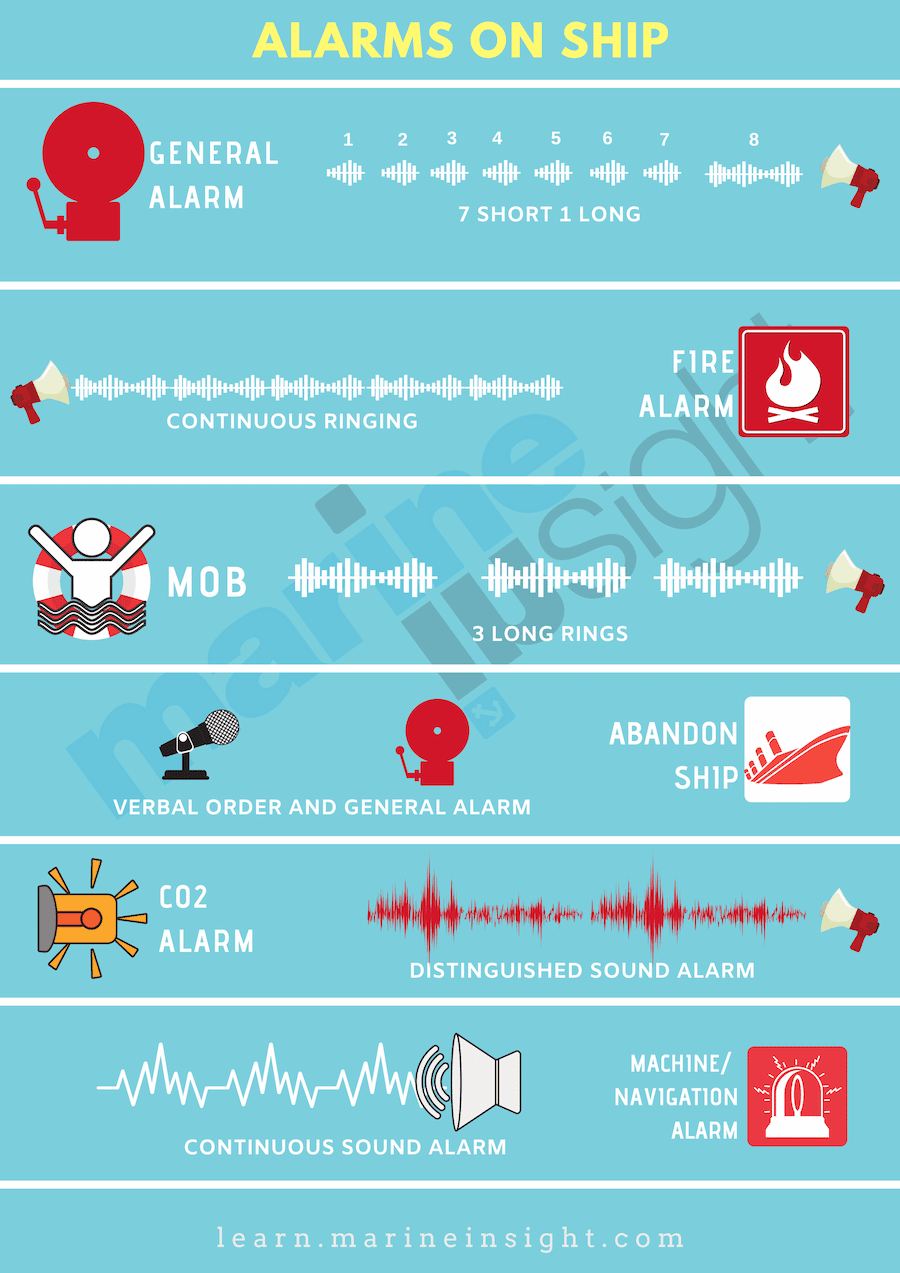Alarm System Continues Dialing After Alarm Trip
A maritime emergency at sea does not come with an alarm. Still, ship emergency signals and alarms can help us tackle a crisis or avoid an emergency efficiently and in the right way.
Emergency signals or alarms on a ship are installed all over the vessel's various systems and machinery to notify the crew about a dangerous situation that can arise from different types of emergencies onboard the ship.
Emergency alarms are of the audible and visual type to ensure that a person can listen to the audible alarm when working in an area where seeing a visual alarm is not possible and vice versa.
It is a standard practice in the international maritime industry to have an emergency alarm on the ship for a particular warning that is similar for all seagoing vessels, no matter in which seas they are sailing or to which company they belong.
Download Practical Maritime eBooks With Amazing Bonuses:
Here are a few fantastic ebooks to get important maritime information in the next couple of minutes!
eBooks For The Smart Mariner

This commonness helps the seafarer know and understand the type of warning/ emergency or ship emergency alarm well and help tackle the situation faster.
Related Reading:
7 Most Common Types of Accidents On Ship's Deck
10 Extremely Dangerous Engine Room Accidents
Types of Alarms on Ships
These are the different types of emergency alarms or signal onboard ship that is installed to give audio-visual warnings:
1)General Alarm:
The general emergency alarm on the ship is recognised by 7 short ringings of the bell followed by a long ring or using the ship horn signal of 7 short blasts followed by 1 long blast.
The general alarm in a ship is sounded to make the crew aware that an emergency has occurred, such as fire, collision, grounding, or a scenario that can lead to abandoning the ship etc.
The vessel general alarm system activation point is located in the navigation bridge. Once the general alarm signal onboard is activated, i.e. seven short one long blasts (7 short 1 long blast), every ship crew must follow the instruction and duty's listed in the muster list and proceed to the designated muster station.
Action to be taken by the crew once ship general alarm is sounded:
- Proceed to the designated muster stations
- Listen to the Public Addressing (PA) system for the type of emergency (usually announced by OOW, Chief officer or Captain) leading to the general alarm on a ship.
- Once the nature of the emergency is known, the crew member must re-group as per the Squad and take corrective action to tackle the situation as per the muster plan.
Related Reading:
Guide to Handle Different Emergency Situations On Ship
Importance of Fire Drills On Ships
2) Fire Alarm on the Ship:
Whenever there is a fire detected on the vessel by its crew, they should raise the alarm signal onboard ship by pressing the nearest fire switch or by loudly and continuously shouting "FIRE FIRE FIRE". The ship's fire alarm signal is sounded as the continuous ringing of the ship's electrical bell or the continuous sounding of the ship's horn.
The fire signal must be a continuous blast of the whistle or electrical bell for not less than 10 seconds. However, in most of the vessels, the fire signal is rung continuously on the alarm bell.
Once the master decides to dismiss the crew from fire stations, the general alarm will be sounded three times, followed by three short blasts of the ship's whistle.
Action to be taken by the crew once the ships fire alarm is sounded:
- Proceed to the fire station
- Confirm the location of the fire
- Perform the duty listed in the muster list as per the team assigned
Related Reading
16 Fire Fighting Appliances and Preventive Measures Onboard Ships
Different Types of Fire Extinguishers Used on Ships
A Guide to Fire Pumps on Ship
3) Man Overboard Alarm:
There have been many situations when a crew working on the ship-side or a passenger in a cruise ship fell in the water at high seas. When a man falls overboard, the man overboard alarm sound signal is activated on the ship.
The MOB alarm signal comprises the vessel's internal alarm bell for 3 long rings to notify the crew onboard, along with 3 long blasts on the ship whistle to inform the other ships in the nearby vicinity.
A man overboard signal comprising light and smoke can also be mounted in the bridge, attached by the side of the lifebuoy. When thrown in the water, it will emit smoke and light to draw the ship's crew or other ship around the vicinity.
Action to be taken by the crew once the ships MOB alarm is sounded:
Read – Ways To Tackle Man Overboard Situation on Ship
4) Abandon Ship Alarm:
When the emergency on board ship goes out of hand, and the ship is no longer safe for the crew on board ship, the signal for abandon ship is given verbally by the master to the station in charge of the crew on the ship's Personal Addressing (PA) system.
More than six short blasts and one prolonged blast on the ship's whistle and the same signal on the general alarm bell is used as an abandon ship alarm or sound signal onboard the ship. However, the alarm sounded is similar to a general alarm; and everybody comes to the emergency muster station where the master or his substitute (Chief Officer) gives a verbal order to abandon the ship.
Action to be taken by the crew once Abandon ship is announced or sounded:
- Carry your lifejacket/ immersion suit to the designated muster station
- Carry any additional items (Blanket/ ration/ water etc.) as stated under the duty in the muster list
- Avoid taking longer routes and routes going from inside the accommodation to the muster station
- Wait for the master's order to abandon the ship
5) Navigational Alarm:
In the navigation bridge, most of the navigational equipment and navigation lights are fitted with failure alarms. If any of these malfunctions, a ship alarm signal on the bridge will be sounded whose details (location, equipment affected, type of problem etc.) will be displayed on the notification screen provided on the bridge navigation panel.
Action to be taken by the crew once the navigational alarm is sounded:
- Check which equipment the alarm is concerning to
- Try to locate the fault due to which the alarm is coming
- Rectify the fault or switch the standby equipment if needed
Related Reading
What is Bridge Navigational Watch & Alarm System (BNWAS)?
What is Integrated Bridge System (IBS) on Ships?
6) Machinery Space Alarm:
The ship's engine room is fitted with different machinery, which is continuously monitored for operation using a control and monitoring system.
The machinery in the engine room has various safety devices and alarms fitted for safe operation. If any machinery malfunctions, a common engine room alarm is operated, and the problem can be seen in the control room alarm panel, which will display the alarm.
Action to be taken by the crew once the engine room alarm is sounded:
- Check which machinery/system the alarm is concerned to
- Try to locate the fault due to which the alarm is coming
- Rectify the fault or switch the standby machinery if needed
Related Reading
12 Ways to Master the Engine Room Watch Keeping Procedure
7) Machinery Space CO2 Alarm:
The machinery space is fitted with a CO2 fixed fire extinguishing system. The audible and visual alarm for the CO2 fixed firefighting system is entirely different from the machinery space alarm and other ship alarm signals for easy reorganisation.
The audible alarms shall be located to be audible throughout the protected space with all machinery operating. The alarms should be distinguished from other audible alarms by adjustment of sound pressure or sound patterns.
The alarm should activate upon opening the release cabinet door, which is used to open and release the CO2 bottle banks.
Action to be taken by the crew once the navigational alarm is sounded:
Read- Crew Action Before Operating Ship's CO2 Fire Extinguishing System
8) Cargo Space CO2 Alarm:
The ship's cargo spaces are also fitted with a fixed firefighting system that has a different alarm when operated. The audible and visual alarm for the CO2 fixed firefighting system is entirely different from other ship alarms; the audible alarm should be distinguished from other ships' alarms by adjusting sound pressure or sound patterns.
Action to be taken by the crew once the navigational alarm is sounded:
- Take a headcount of the crew
- Ensure the cargo hold is sealed and no crew is inside
- Ensure all the ventilation systems for the cargo hold are shut
Related Read:8 Mistakes You Should Never Make While Handling CO2 Fire Fighting System
9) Ship Security Alarm System:
As per the SOLAS Chapter XI regulation XI-2/5, all ships shall be provided with a ship security alert system. The Ship Security Alarm system (SSAS) is silent sounded in a pirate attack emergency. When the SSAS is activated, no alarm is sounded on board the ship nor alerts other vessels in the vicinity. Instead, this signal notifies different coastal authorities or competent authorities whose proximity to the ship is presently operating via a global satellite system to inform about the piracy.
Different Alarm signals of the vessel are clearly described in the muster list and the action to be carried out so that all the crew members can perform their duties within no time in an actual emergency.
It is of extreme importance that a seafarer knows the different types of alarms in a ship and recognise which emergency it represents.
Related Read:
- The ISPS Code For Ships – An Essential Quick Guide
- What is Bridge Navigational Watch Alarm System (BNWAS)?
- Bridge of a Ship: Design And Layout
- Different Entries To Be Made In Bridge Log Book of The Ship
- Sprinkler System: Automatic Fire Detection, Alarm and Extinguishing System on Ship
Disclaimer: The authors' views expressed in this article do not necessarily reflect the views of Marine Insight.Data and charts, if used, in the article have been sourced from available information and have not been authenticated by any statutory authority. The author and Marine Insight do not claim it to be accurate nor accept any responsibility. The views constitute only the opinions and do not constitute any guidelines or recommendations on any course of action to be followed by the reader.
The article or images cannot be reproduced, copied, shared or used in any form without the permission of the author and Marine Insight.

An ardent sailor and a techie, Anish Wankhede has voyaged on a number of ships as a marine engineer officer. He loves multitasking, networking, and troubleshooting. He is the one behind the unique creativity and aesthetics at Marine Insight.
Related Posts
Source: https://www.marineinsight.com/marine-safety/different-types-of-alarms-on-ship/
0 Response to "Alarm System Continues Dialing After Alarm Trip"
Post a Comment